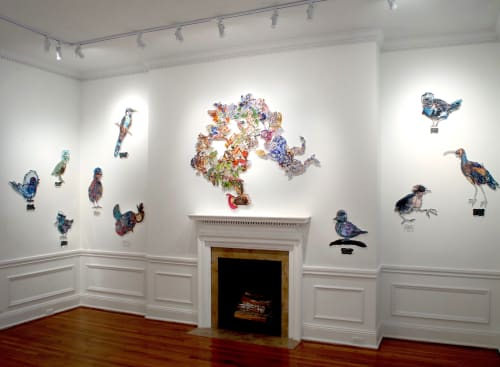MIYAKO YOSHINAGA presents a new solo exhibition, Silent Spring by Dominique Paul (b.1967), a Canadian artist based in Montréal and New York. This is the artist's third solo exhibition and her first presentation at the gallery's Upper East Side location. The exhibition will run from September 25 to November 21, 2020. The gallery hours are from Wednesday through Saturday, 11am - 6pm.
Rachel Carson's 1962 prophetic essay Silent Spring was critical in the banning of DDT. Today we find ourselves witnessing the steep decline in the species of insects and birds that Carson predicted over 60 years ago. In 2011, in response to the inexorable and seemingly irreversible human intrusion into nature, Dominique Paul began her ongoing series of surrealistic collages in which she juxtaposes human body parts from contemporary sources with early 18th century botanical illustrations from "Insects of Surinam" by Maria. S. Merian (1647-1717). These illustrations are known for being the first such documentation of insect metamorphoses in their habitats. Once the collages are set, Paul photographs the whole, thus forging the two different eras into a fascinating and somewhat unsettling composite.
In Paul's series bearing the same title as Merian's illustrations, as humans become an invasive species, they cause plants to evolve into grotesque hybrid forms. The exhibition highlights two bas-relief trees in which Paul uses laser-cut acrylic exoskeletons to emphasize the symbiotic relationship between the human element and nature. For example, in Insects of Surinam 35 (2019), these trees appear to reject and shed superfluous luxury products such as handbags, jewelry and watches -symbolizing the little time we have left before our natural resources are exploited to extinction in the service of consumer greed.
This exhibition also introduces new collages based on Paul's original drawings of bumblebees and birds at risk. In this series, human body parts and consumer products give form to insects and birds, illustrating the plight of the numerous threatened species of North America. Referring to the images of African-American men and women used in her work, Paul cites the groundbreaking laws adopted for both the environment and Civil Rights in the early 1960s that have still not been resolved and are now the top political agendas in the United States. Given this parallel as well as the fact that minorities have been disproportionately victimized by our increasingly hazardous environment, Paul's work strives to honor their resilience and self-empowerment.
Dominique Paul is a multidisciplinary artist who works with photography, collage, drawing, and performance with wearable structures. Paul received her MFA at the College of Fine Arts, UNSW, Sydney, Australia and her Doctorate in the Study and Practice of Arts from the University of Quebec. She has shown and performed at venues such as the Art Museum of the Americas, Washington D.C., and the Royal Academy of Antwerp. Her work can be seen in various international collections i.e. the Smithsonian Museum Institution, D.C, the Contemporary Art Museum, Beijing, the Coppell, Mexico, the Musée d'art contemporain de Lyon, the Arthotèque d'Annecy, France, and the Musée d'art contemporain des Laurentides, Quebec, Canada. For this exhibition, Paul has received generous support from Conseil des Arts et des Lettres du Québec, Agglomération de Longueuil, Conseil des Arts de Longueuil, Encadrex, and the Quebec Government Office in New York.


